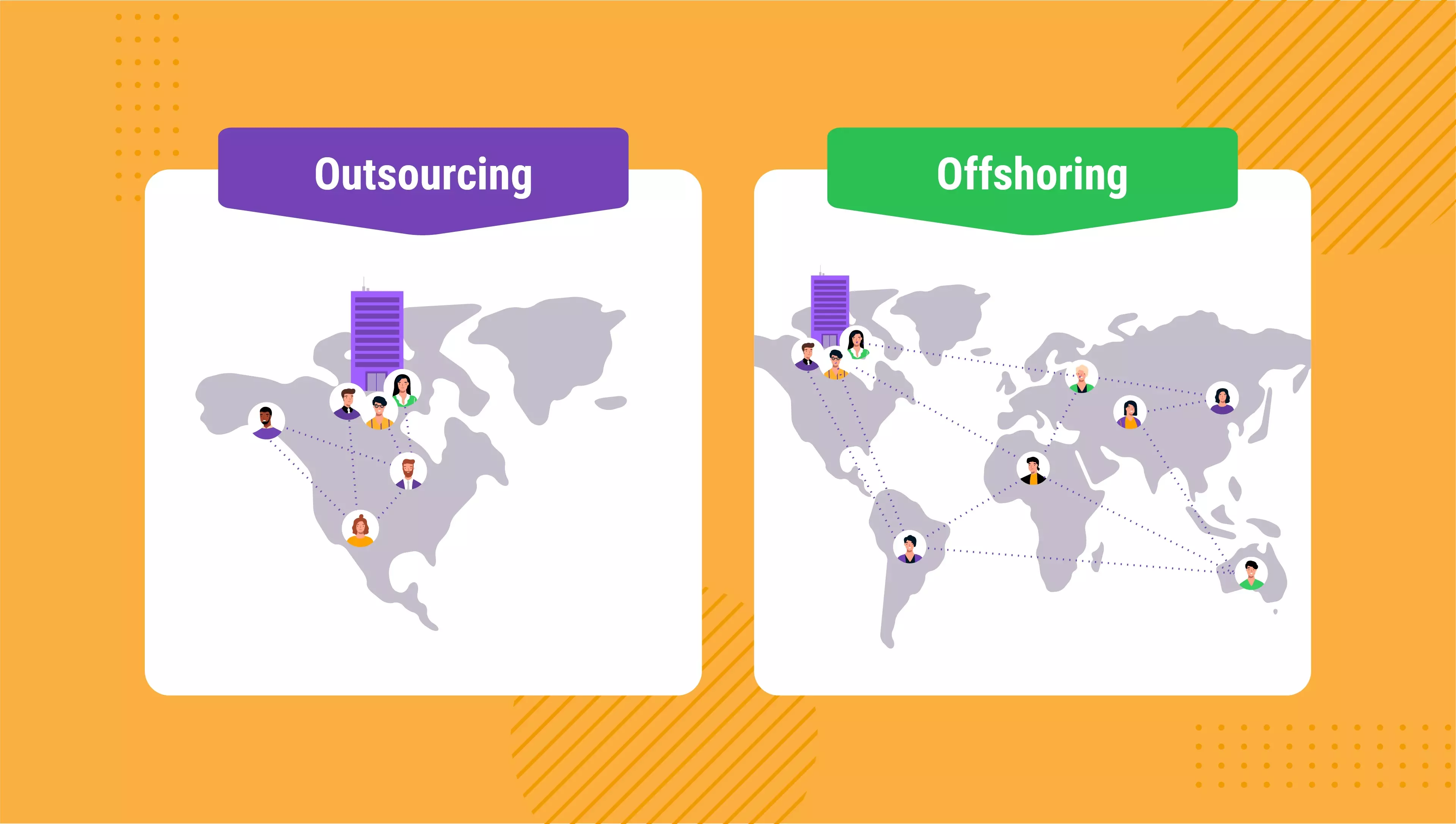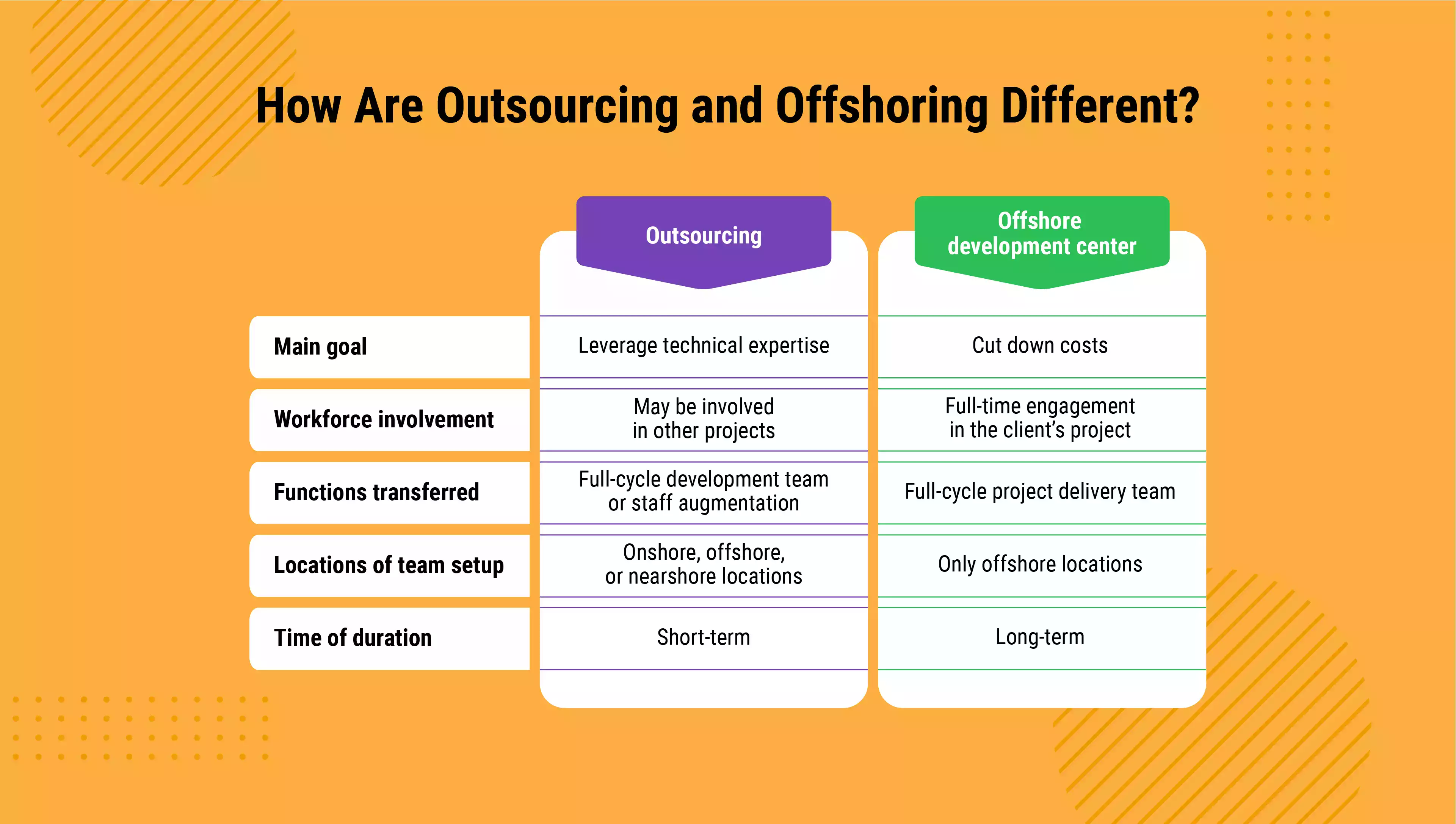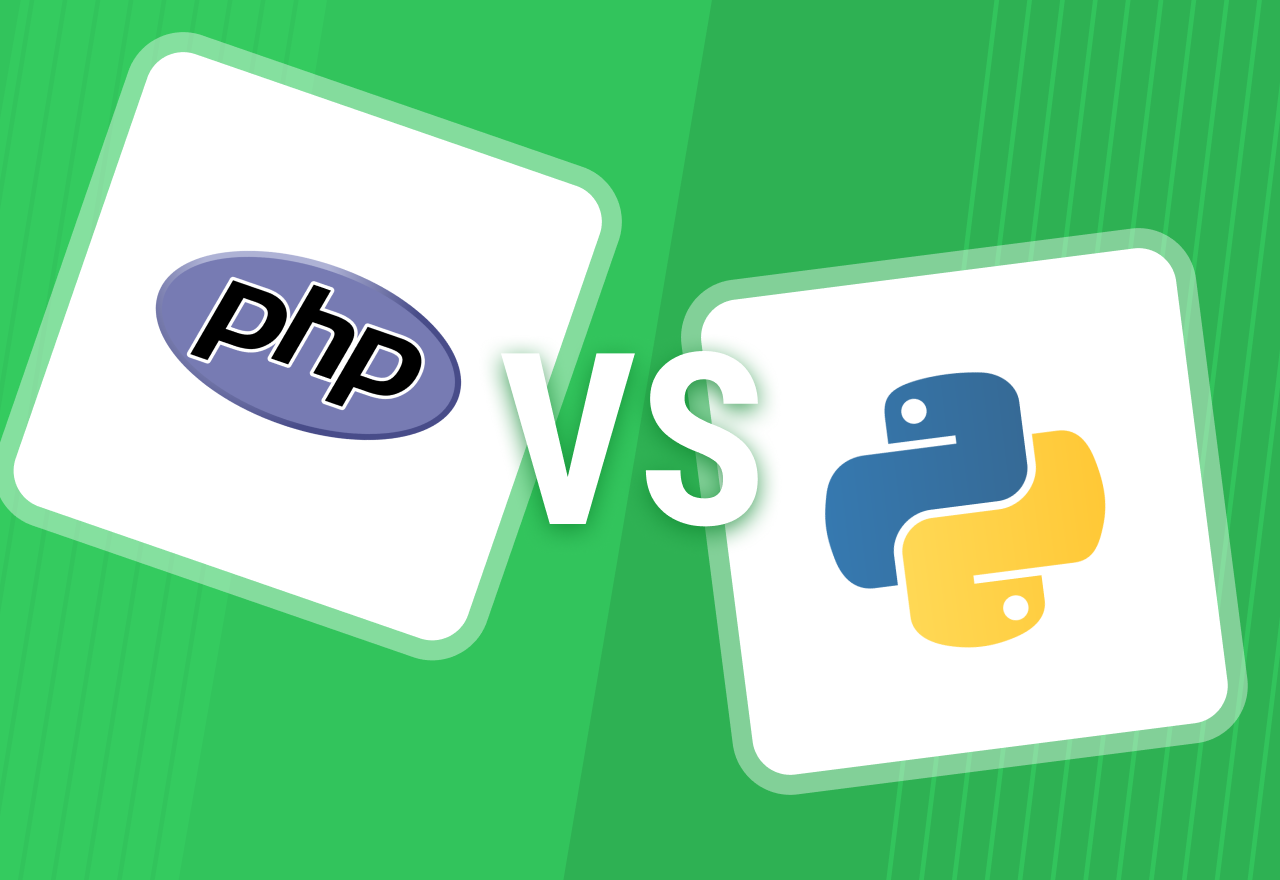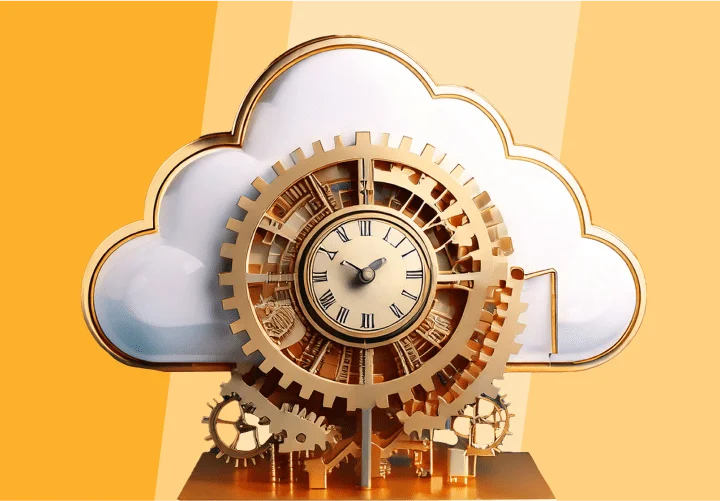IT Outsourcing and Offshoring: Choosing the Right Partner in the Era of Digital Transformation
Table of contents
- What’s the Difference Between Outsourcing and Offshoring?
- 1. Meaning
- 2. Main goal
- 3. Workforce involvement
- 4. Functions transferred
- 5. Locations of team setup
- 6. Time of duration
- Understanding Offshore Development Center Approach
- Assess your project goals
- Define the time-frame of the project
- Plan your staff resources
- Define the location of the remote team
- Emerging Trends in IT Outsourcing and Offshoring (2025-2030)
- AI and automation
- Cybersecurity as a top priority
- ESG and ethical outsourcing
- Specialized niches and deep expertise
- Flexible engagement models and "multi-sourcing"
- Hybrid and multi-cloud strategies
- Evolution of specific development areas
- Web development: beyond just websites
- Mobile development: ecosystems and new interfaces
- E-commerce: personalization and metaverses
- Final Thoughts
Outsourcing is the high-level term used to describe contracting a third party to execute tasks assigned to them. Formally, offshoring is one of a number of outsourcing strategies, including onshoring and nearshoring outsourcing. Outsourcing and offshoring are similar in the most basic meaning — you assign tasks to external employees. However, there are several key differentiators that make these two approaches work for completely different needs. Understanding them will help you decide which one will work best for your company.
What’s the Difference Between Outsourcing and Offshoring?
1. Meaning
Outsourcing is the process where a client contracts the execution of specific tasks to a third-party company specializing in the services they need. Companies can outsource a wide variety of tasks, from marketing to software development. In the IT sector, outsourcing includes services such as turnkey software development, as well as testing, design, DevOps, and more.
Offshoring refers to the transferring of business operations to another country to reduce costs. Compared to outsourcing, you may not transfer processes to a contractor and proceed with them in-house. However, you may also transfer some of your processes to a service provider to set up an offshore development center.
2. Main goal
Companies lacking technical expertise often outsource full-cycle projects or particular processes to outsourcing providers with a larger pool of tech talent. Clients might also possess strong technical expertise but need to scale their staff quickly. In such cases, they can leverage staff augmentation services, a specific subdivision of outsourcing.
The main intention of offshoring is often to cut down costs. That’s why most clients in the IT industry choose more cost-effective locations for opening an offshore development center as they can save on costs thanks to lower salaries in some regions, lower tax rates, etc.
3. Workforce involvement
Outsourcing development services does not always mean that the staff provided by the contractor is not involved in other projects, unless you hire a dedicated development team. Moreover, they aren’t considered your in-house employees and will work under the provider’s policies, regulations, and workflows. Unlike firms that outsource, firms engaged in offshoring and offering offshore development services provide the staff to work in a slightly different scenario. When opening an ODC, employees are hired as a remote workforce dedicated to the client’s company only as if they were hired as an in-house team but working in an offshore country.
4. Functions transferred
When it comes to outsourcing services, they typically refer to transferring a single task or process. Companies may augment their in-house team with additional human resources, entrust mobile development based on the provided UI design, sometimes even entrust full-cycle software development from scratch. Still, when launching an ODC, companies engage a remote team from another country to more complex tasks that require a more deep dedication and high-quality specialists.
5. Locations of team setup
Offshoring differs from outsourcing because remote teams or employees are located in a foreign country where team setup costs are lower. While outsourcing tasks, you can transfer them to a company located in another country, or within your native country. The main differentiator here is not where it's performed, but by whom it's done, and they aren't your in-house staff.

6. Time of duration
Finally, outsourcing and offshore development projects are efficient during different periods of time. Outsourcing is more efficient for quick scaling and satisfying temporary workforce needs.
An offshore development center allows you to scale your business and is perfect for companies requiring full-time employee involvement. By launching an ODC with a few employees, you can expand your business by adding new roles, while entrusting the hiring process to your ODC setup partner.

Understanding Offshore Development Center Approach
Most people view offshore outsourcing as beneficial for long-term cooperation. For such projects, an offshore development center offers reduced administrative costs, flexible project scaling, cost-effective infrastructure, and other benefits.
If you’re new to the ODC approach, you should read our dedicated material ‘’What is an offshore development center?’’ where we outline its benefits, challenges, and present a 5-step guide to ODC setup.
Meanwhile, if you’re thinking about business scaling opportunities, have a look at the tips that will help you understand whether ODC will serve you better.
Assess your project goals
Before searching for project delivery partners, it’s essential to evaluate your project and identify what your key objective is. Clarify the reason why you will transfer some of your tasks or the whole project to a software development partner. If it refers to saving costs on in-house development, infrastructure, hiring, and other aspects, then ODC may be your best choice.
Define the time-frame of the project
At this stage, you need to estimate at least approximately when the project will be completed. If it requires long-term cooperation with continuous scaling, then ODC will work for you.
Plan your staff resources
Then consider what positions you need to start expanding your business. Assess your in-house expertise and your ability to control the overall project delivery. In case your project requires a dedicated development team staffed with technical specialists and delivery management, but at the same time, you want to have control over the process, ODC would be a good option.
Define the location of the remote team
Finally, if you choose to hire specialists from less expensive countries, or offshore locations, it’s where ODC setup services will serve your needs.
Once you determine that an offshore development center is what you need, proceed with reading the 5-step guide to finding the right partner.
Emerging Trends in IT Outsourcing and Offshoring (2025-2030)
The IT outsourcing and offshoring market continues to evolve rapidly, adapting to new technologies and changing business needs. The following trends will define the industry's development from 2025 to 2030.
AI and automation
Impact on Productivity: AI, especially generative AI and robotic process automation, are fundamentally transforming outsourcing. They automate routine tasks (testing, support, infrastructure management, even some coding), freeing up human resources for more complex and strategic initiatives. This boosts efficiency, reduces errors, and accelerates time-to-market.
Demand for AI specialists: There's a growing demand for outsourcing teams with deep expertise in AI, machine learning, big data processing, and prompt engineering. Companies will actively seek partners capable of developing and implementing AI solutions.
Process optimization: AI will be used to optimize the outsourcing process itself – from team selection and project management to risk prediction and performance analysis.
Cybersecurity as a top priority
Growing threats: With increasing cyber threats and stricter regulatory requirements (GDPR, CCPA, etc.), cybersecurity has become a critically important aspect when choosing an outsourcing partner.
Specialized services: Companies will actively outsource cybersecurity functions, including threat monitoring, vulnerability management, incident response, regulatory compliance, and the implementation of Zero-Trust principles.
Trust and transparency: Partnerships will be built on a high level of trust, transparency in data security matters, and strict adherence to protection protocols.
ESG and ethical outsourcing
Social responsibility: Companies are increasingly focusing on ESG factors when selecting partners. This includes environmental sustainability (energy efficiency, carbon footprint reduction), social responsibility (fair labor practices, community support), and corporate governance.
"Green" IT: There will be a growing demand for "green" IT solutions and providers who implement sustainable practices in their operations, such as energy-efficient data centers, reduction of e-waste, and the use of renewable energy sources.
Specialized niches and deep expertise
From general to niche: Instead of a broad profile, outsourcing companies will increasingly focus on deep expertise in specific technologies or industries (e.g., FinTech, HealthTech, EdTech, GameDev, blockchain, quantum computing, IoT).
"Talent-as-a-service": The "talent-as-a-service" model will become even more in-demand, allowing companies to quickly access rare and highly specialized skills without the need for in-house hiring and training.
Flexible engagement models and "multi-sourcing"
Adaptability: The demand for flexible contract models (e.g., pay-as-you-go, time-and-materials, dedicated teams) will continue to grow, enabling companies to quickly adapt to changing market needs and scale resources.
Multiple partners: Companies will increasingly use "multi-sourcing" — working with several outsourcing partners for different tasks to diversify risks, leverage the strengths of various providers, and access a broader talent pool.
Hybrid and multi-cloud strategies
Cloud solutions: Outsourcing the management of cloud infrastructure (private, public, hybrid, and multi-cloud solutions) will become even more sought after. Providers will play a key role in optimizing resource utilization, ensuring data security, and managing complex cloud environments.
Edge computing: The development of Edge computing will lead to an increased demand for outsourcing related to data processing closer to the source, improving performance and reducing latency for real-time applications.
Evolution of specific development areas
Web development: beyond just websites
Generative AI in design and development: AI will be actively used to automate code generation, optimize UI and design, and create personalized content and videos.
Hyper-personalization and AI-driven UX: Websites will dynamically adapt to user behavior, offering highly relevant content and experiences through AI and machine learning.
VUI and voice search: Optimization for voice search and voice interfaces will become standard as users increasingly interact with devices by voice.
Web3 and decentralization: The adoption of Web3 technologies, including blockchain and dApps, will gain momentum, creating new opportunities for secure and transparent interactions.
Minimalist and functional design: Simplicity, fast loading speeds, and intuitive navigation will be priorities, enhancing the user experience.
AR and VR in web: AR/VR experiences will be integrated directly into web applications for interactive product demonstrations, virtual tours, and learning.
Mobile development: ecosystems and new interfaces
AI and ML in applications: Deep integration of AI for personalization, recommendations, natural language processing, and predictive analytics will become ubiquitous.
5G and Edge computing: The evolution of 5G will provide ultra-fast connectivity and low latency, enabling the creation of more complex and interactive mobile applications that leverage Edge Computing for local data processing.
Super apps: The trend towards creating "super apps" that combine multiple services (messengers, payments, shopping, ride-hailing, etc.) within a single platform will continue.
AR/VR and metaverses: Mobile applications will become the primary gateway to metaverses, offering immersive AR/VR experiences for gaming, education, shopping, and social interactions.
PWAs: PWAs will continue to evolve, providing a native-like user experience through the browser, blurring the lines between websites and mobile applications.
Enhanced cybersecurity: Given the rise in mobile threats, application security (data protection, authentication, encryption) will become even more critical.
E-commerce: personalization and metaverses
AI-driven commerce: AI will be at the core of shopping personalization (product recommendations, virtual assistants), pricing optimization, demand forecasting, and customer service automation (chatbots).
Social commerce: Direct sales through social media platforms (TikTok, Instagram, etc.) will become a dominant channel, potentially bypassing traditional online stores. The influence of influencers and viral trends will be immense.
AR in shopping: AR technologies (virtual try-ons, placing furniture in a room) will become a standard feature, enhancing the product selection experience.
Metaverse and Web3 in E-commerce: Brands will create virtual stores and shopping experiences in metaverses, using NFTs and other blockchain technologies for unique products and loyalty programs.
Sustainability: Consumers will increasingly favor brands demonstrating environmental and social responsibility. Demand for "green" delivery, recyclable packaging, and transparent supply chains will grow.
"Buy now, pay later" and new payment systems: BNPL and cryptocurrencies will become more common payment options, offering consumers greater flexibility.
Omnichannel and seamless experience: The integration of online and offline channels to create a single, continuous customer journey will become even more vital.
Final Thoughts
While outsourcing and offshoring may sound similar, they are quite different. No matter what approach you would choose for growing your business, it’s better to share this journey with a reliable partner.
Being recognized as one of the Top Offshore Software Development Companies for quality delivery of software development, we strive to adjust our service to our clients' needs. Find out more about our ODC setup services and contact us for more information.
Updated on Oct 6, 2025





